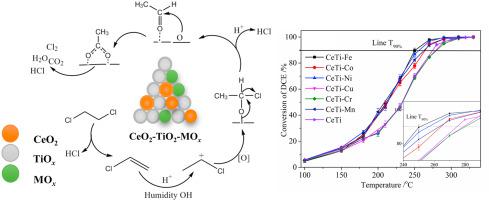Journal of Rare Earths ( IF 4.9 ) Pub Date : 2021-02-16 , DOI: 10.1016/j.jre.2021.02.005 Yijun Shi 1 , Xiaolin Guo 2 , Zhinan Shi 1 , Renxian Zhou 1

|
A series of transition metals (Fe, Co, Ni, Cu, Cr and Mn)-doped CeO2–TiO2 catalysts were prepared by the sol–gel method and applied for the catalytic removal of 1,2-dichloroethane (DCE) as a model for chlorinated VOCs (CVOCs). The various characterization methods including X-ray diffraction (XRD), N2 adsorption–desorption, UV-Raman, NH3 temperature-programmed desorption (NH3-TPD) and H2 temperature-programmed reduction (H2-TPR) were utilized to investigate the physicochemical properties of the catalysts. The results show that doping Fe, Co, Ni or Mn can obviously promote the activity of CeO2–TiO2 mixed oxides for DCE degradation, which is related to their improved texture properties, acid sites (especially for strong acidity) and low-temperature reducibility. Particularly, CeTi–Fe doped with moderate Fe exhibits excellent activity for 1,2-dichloroethane (DCE) degradation, giving a T90% value as low as 250 °C. More importantly, only trace chlorinated byproducts were produced during the low-temperature degradation of various CVOCs (dichloromethane (DCM), trichloroethylene (TCE) and chlorobenzene (CB)) over CeTi–Fe1/9 catalyst with high durability.
中文翻译:

CeO2-TiO2对氯化VOCs降解的过渡金属掺杂效应和高催化活性
采用溶胶-凝胶法制备了一系列过渡金属(Fe、Co、Ni、Cu、Cr和Mn)掺杂的CeO 2 -TiO 2催化剂,并应用于1,2-二氯乙烷(DCE)的催化去除。氯化 VOC (CVOC) 模型。采用了多种表征方法,包括 X 射线衍射 (XRD)、N 2吸附-脱附、UV-Raman、NH 3 程序升温脱附 (NH 3 -TPD) 和 H 2 程序升温还原 (H 2 -TPR)研究催化剂的物理化学性质。结果表明,掺杂Fe、Co、Ni或Mn均能明显促进CeO 2 -TiO 2的活性。用于 DCE 降解的混合氧化物,这与它们改善的织构特性、酸性位点(尤其是强酸性)和低温还原性有关。特别是,掺杂适量 Fe 的 CeTi-Fe 表现出优异的 1,2-二氯乙烷 (DCE) 降解活性,T 90%值低至 250 °C。更重要的是,在具有高耐久性的 CeTi-Fe1/9 催化剂上低温降解各种 CVOC(二氯甲烷(DCM)、三氯乙烯(TCE)和氯苯(CB))过程中仅产生微量的氯化副产物。

























 京公网安备 11010802027423号
京公网安备 11010802027423号